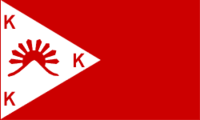
Pio del Pilar
Encyclopedia


Philippines
The Philippines , officially known as the Republic of the Philippines , is a country in Southeast Asia in the western Pacific Ocean. To its north across the Luzon Strait lies Taiwan. West across the South China Sea sits Vietnam...
. He was born as Pío Castañeda Isidro. To safeguard his family and prevent them from harassment, he changed his surname to del Pilar. He was born in Barrio Culi-culi (now Pio del Pilar), San Pedro de Makati on 11 July 1865.
In May 1896, he joined the Katipunan
Katipunan
The Katipunan was a Philippine revolutionary society founded by anti-Spanish Filipinos in Manila in 1892, whose primary aim was to gain independence from Spain through revolution. The society was initiated by Filipino patriots Andrés Bonifacio, Teodoro Plata, Ladislao Diwa, and others on the night...
and formed a chapter called Matagumpay (Triumphant), taking the symbolic name Pang-una (Leader). He was, however, arrested by the Spanish authorities who tried to force him to reveal the roster of the Katipunan
Katipunan
The Katipunan was a Philippine revolutionary society founded by anti-Spanish Filipinos in Manila in 1892, whose primary aim was to gain independence from Spain through revolution. The society was initiated by Filipino patriots Andrés Bonifacio, Teodoro Plata, Ladislao Diwa, and others on the night...
.
He designed a war flag for his chapter, a blood-red flag with a white triangle with the letter "K" in each angle, and in the middle, a half sun with seven rays.
He led a group of rebels in the Battle of Binakayan on November 9, 1896, capturing the town from Spanish authorities.
His last battle was with the Americans, in the town of Morong
Morong, Rizal
Morong is a 3rd class municipality in the province of Rizal, Philippines. According to the latest census, it has a population of 50,538 inhabitants in 8,988 households. A popular attraction is Spanish-era St. Jerome's Parish Church...
. He fought bravely but he and his men were defeated and captured.
He died on 21 June 1931 at the age of 65 due to lingering illness.
Role in Philippine Revolution
A Magdiwang General and one of the closest officers of the Supremo of Katipunan, Andrés BonifacioAndres Bonifacio
Andrés Bonifacio y de Castro was a Filipino nationalist and revolutionary. He was a founder and later Supremo of the Katipunan movement which sought the independence of the Philippines from Spanish colonial rule and started the Philippine Revolution...
. Bonifacio went to Cavite
Cavite
Cavite is a province of the Philippines located on the southern shores of Manila Bay in the CALABARZON region in Luzon, just 30 kilometers south of Manila. Cavite is surrounded by Laguna to the east, Metro Manila to the northeast, and Batangas to the south...
to mediate with Magdiwang
Magdiwang
Magdiwang can refer to the following:*Magdiwang , a faction of the Katipunan*Magdiwang, Romblon, a Philippine municipality...
and Magdalo
Magdalo (Katipunan faction)
The Magdalo faction of the Katipunan was a chapter in Cavite, mostly led by ilustrados of that province.It was named after Mary Magdalene...
faction that become the Tejeros Convention
Tejeros Convention
The Tejeros Convention was the meeting held between the Magdiwang and Magdalo factions of the Katipunan at San Francisco de Malabon, Cavite on March 22, 1897...
then that Naic Military Agreement that declares the nullity of the Tejeros Convention wherein he was also one of the signatories.
In time, he changed side, becoming one of Emilio Aguinaldo’s trusted generals. It was del Pilar (along with Gen. Mariano Noriel including Gen. Artemio Ricarte) that advised Aguinaldo to change the commutation (banishment) to execution of Andrés and Procopio Bonifacio.
During the Filipino-American War, he was captured but never sworn allegiance to the American Flag and exiled to Guam
Guam
Guam is an organized, unincorporated territory of the United States located in the western Pacific Ocean. It is one of five U.S. territories with an established civilian government. Guam is listed as one of 16 Non-Self-Governing Territories by the Special Committee on Decolonization of the United...
. He continued to fight for the cause of the Filipino people by supporting Jones Bill for Filipino’s preparation for self governance.

